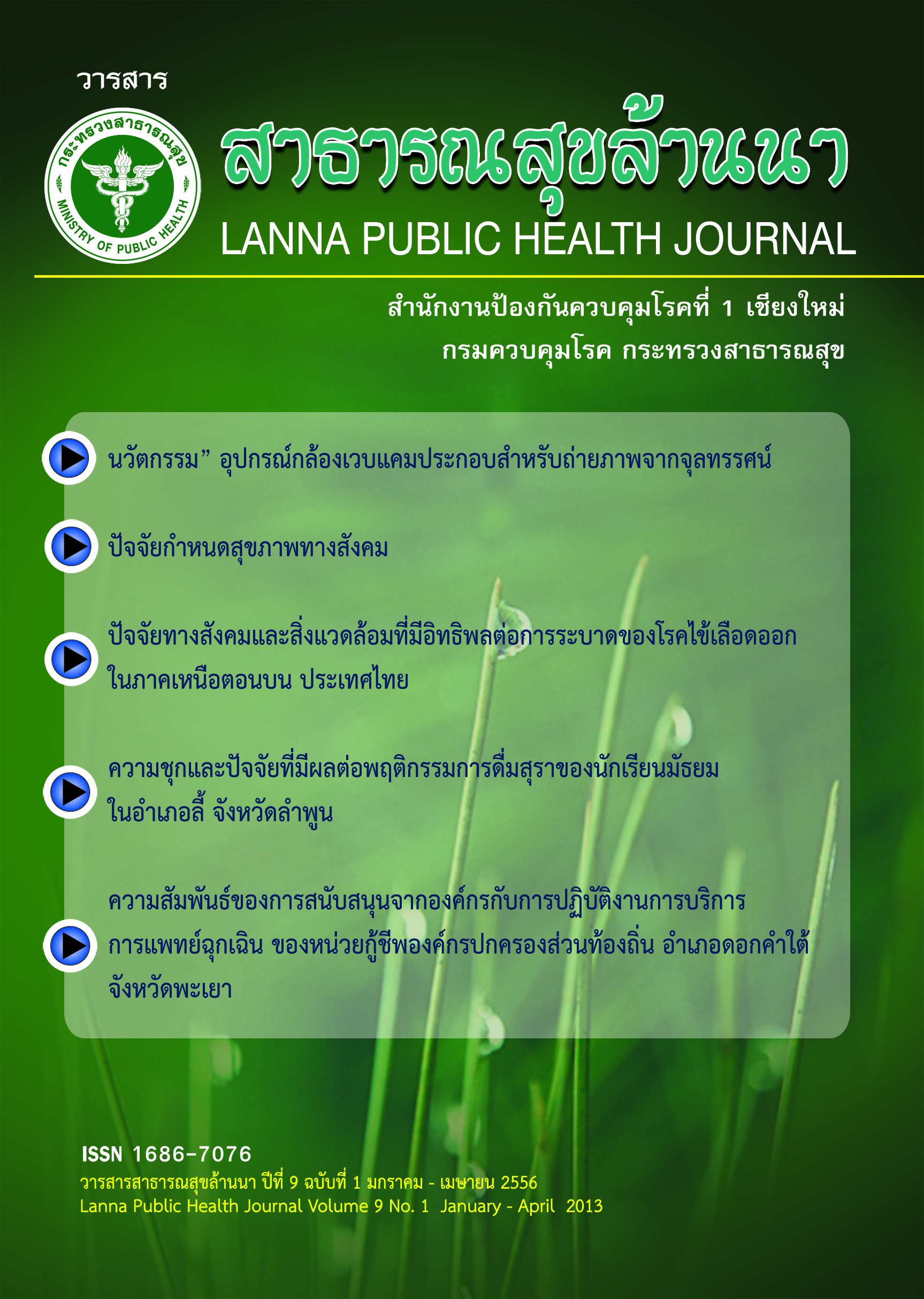ปัจจัยทางสังคมและสิ่งแวดล้อมที่มีอิทธิพลต่อการระบาดของโรคไข้เลือดออก ในภาคเหนือตอนบน ประเทศไทย
คำสำคัญ:
ปัจจัยทางสังคมและสิ่งแวดล้อม, รูปแบบพยากรณ์การระบาดของโรคไข้เลือดออก, ค่าดัชนีลูกน้ำยุงลาย, ความชื้น, ปริมาณน้ำฝนบทคัดย่อ
การวิจัยนี้เป็นการวิจัยเชิงประยุกต์ (Applied research) มีวัตถุประสงค์เพื่อศึกษาปัจจัยที่มีผลต่อการระบาดของโรคไข้เลือดออกและเพื่อสร้างรูปแบบการพยากรณ์การระบาดของโรคไข้เลือดออกใน 8 จังหวัดภาคเหนือ โดยคัดเลือกพื้นที่ที่มีการป่วยด้วยไข้เลือดออกซ้ำหรือมีผู้ป่วยโรคไข้เลือดออกในหมู่บ้าน/ชุมชนติดต่อกัน ภายใน 28 วัน หรือหมู่บ้านที่โรคไม่สงบภายใน 28 วัน (Second generation) ซึ่งเป็นพื้นที่เสี่ยงสูงต่อการระบาด ใช้วิธีเก็บข้อมูลทุติยภูมิ (Secondary data) ได้แก่ ข้อมูลทางด้านภูมิศาสตร์ ยุงพาหะ ระบาดวิทยาไข้เลือดออกได้แก่ ปริมาณน้ำฝน อุณหภูมิ ความชื้น ความชุกชุมของลูกน้ำยุงลายระดับตำบล ตั้งแต่ปี 2549 -2553 ส่วนข้อมูลที่เกี่ยวข้องกับด้านระบาดวิทยาเชิงสังคม ใช้วิธีสำรวจข้อมูลปฐมภูมิ (Primary data)ได้แก่ ลักษณะทางประชากรและการเคลื่อนย้าย ความรู้ การรับรู้ และพฤติกรรมการป้องกันควบคุมไข้เลือดออกของประชาชน ประวัติการป่วยเป็นไข้เลือดออก การมีส่วนร่วมของประชาชน ด้วยแบบสอบถามประชาชนในพื้นที่ 16 หมู่บ้านใน 8 จังหวัดได้จำนวนรวม 1,090 คน วิเคราะห์ข้อมูลทางสถิติ โดยใช้ค่าร้อยละ ค่าเฉลี่ย ส่วนเบี่ยงเบนมาตรฐานค่าไคสแควร์ และการวิเคราะห์การถดถอยพหุโลจิสติกส์ผลการศึกษาพบว่า ปัจจัยที่เกี่ยวข้องกับการระบาดของโรค ได้แก่ ค่าดัชนีลูกน้ำยุงลาย (Container index) ที่เพิ่มขึ้น 1 หน่วย ทำให้การระบาดของโรคไข้เลือดออกเพิ่มขึ้น 1.76 เท่า การไม่นอนในมุ้งเวลากลางวันทำให้การระบาดของไข้เลือดออกเพิ่มขึ้น 3.25 เท่า ความชื้นเฉลี่ยลดลง 1 หน่วย ทำให้การระบาดของไข้เลือดออกเพิ่มขึ้น 8.96 เท่า และปริมาณน้ำฝนที่ลดลง 1 หน่วยทำให้การระบาดของไข้เลือดออกเพิ่มขึ้น 1.05 เท่าโดยมีค่าสัมประสิทธิ์การพยากรณ์ (R2) เท่ากับร้อยละ 80.7 และได้สมการการทำนายใช้เป็นรูปแบบได้ดังนี้ Y/= -145.525 + 0.566CI + 1.180Bn + 2.193Humid - 0.052Rainfall
เอกสารอ้างอิง
Biswas D., Dey S., Dutta RN, HatiAk. Observation on the breeding habitats of Aedes aegypti in Calcutta following an episode of deague hemorrhagic fever. Indian J Med Res 1993; 97: 44 - 6.
Butraporn P., Saelim W, Sitaputra P, Tantawiwat S. Establishment of environmental master team to Control dengue haemorrhagic fever by local wisdom in Thailand. Dengue Bulletin 1999; 23: 99 -104.
Gubler DJ. (a). Epidemic dengue/dengue haemorrhagic fever: A global public Health problem in the 21st century in the World Helth organization, the South East Asia and Western pacific Region. Dengue Bulletin 1997; 21: 1 - 13.
Gubler DJ. Epidemic dengue/dengue hemorrhagic fever as a public health, social and economic problem on the 21st century. Trends Microbiol 2002; 10(2): 100 – 3.
Hales S, We Neil de, Maindonald J, Woodward A. Potential effect of population and climate Changes on global distribution of dengue fever: an empirical model. THE LANCET 2002; 360; 830 - 4.
Hammon WM, Rudnik A, Sather GE.Viruses associated with epidemic hemorrhagic fever of the Philippines and Thailand. Science 1960; 131: 1102 - 3.
Koopmam JS, Prevots R, Martin MA, et al. Determinant and predictors of Dengue infection in Mexico. Am J Epidemol 1991: 133; 1168-78.
Koenraadt C, Tuiten W, Sithiprasasna R, Kijchalao U, Jones J, Scott T. Dengue knowledge and practices and their impact on Aedesaegypti populations in Kamphaeng Phet,
Thailand. American J of Trop Med Hyg 2006; 74(4): 692–700.
Lemeshow S, Hosmer DW, Klar J, Lwanga SK. Adequacy of Sample Size in Health Studies. World Health Organization.John Wiley and Sons Ltd., 1990; p.1-8.
Martens P, Kovas R., Nijhof S et al. Climate change and future populations at risk of malaria. Global Environ Change 1999; 9: 89-107.
Martens WJM, Jetten TH, Focks DA. Sensitivity of malaria, schistosomiasis and dengue to global warming. Climate change 1997; 35: 145-56
Rosembaum J, Nathan MB, Ragoonanansign R, Rawlins S, Gayle C, Chadee DD, Lloyd LS. Community participation in dengue prevention and control: a survey of knowledge, attitudes, and practice in Trinidad and Tobago. Am J Trop Med Hyg 1995; 53(2); 111-7.
Schultz GW., Seasonal abundance of dengue vectors in Manila, Republic of Philippines. Southeast Asian J Trop Med Public Health 1993; 24: 369-75.
Shekhar KC., Huat OL. Epidemiology of Dengue/ Degue Hemorrhagic Fever in Malaysia-a retrospective epidemiological study 1973-1987. Part I. Dengue Hemorrhagic fever. Asia Pac J Public Health 1992; 6: 15-25.
Suwonkerd W, Mongkalngkoon P, Parbaripai A, Grieco J, Achee N, Roberts D and Viriyaphap T. The effect of host type on movement patterns of Aedes aegypti (Diptera:Culicidae) into and out of experimental huts in Thailand. J of Vector Ecology 2006; 31(2): 311-18.
Thammapalo S, Chongsuwiwatwong V, McNell D, Geater A. The Climate Factors influencing the occurrence of Dengue Hemorrhagic Fever in Thailand. Southeast Asian J Trop Med Public Health 2006; 36(1): 191- 96.
Thammapalo S, Nagao Y, Sakamoto W, Sangtharatip S, Tsujitani M, Nakamura Y, Colema PG, Davies C. Relationship between Transmission Intensity and Incidence of Dengue Hemorrhagic Fever in Thailand. PLOS Neglected Tropical Diseases 2008; 2(7): 1-13.
Vu Dinh Thiem, Motoi Suzuki, Hideki Yanai, Toru Matsubayashi, Lay-Myint Yoshida, Le HuuTho, Truong Tan Minh, Dang DucAnh, Paul E. Kilgore, Masahiro Takagi, and
KoyaAriyoshi. Can Daytime Use of BedNets Not Treated with Insecticide Reduce the Risk of Dengue Hemorrhagic Fever Among Children in Vietnam?. Am J Trop Med Hyg
2010; 82(6): 1157–59.
Van Benthem B. H. B, Khantikul N., Panart K., Kessels P. J., Somboon P. and Oskam L. Knowledge and use of prevention measures related to dengue in Northern Thailand.
Trop Med Int Health 2002; 7(11): 993 - 1000.
Van Benthem B.H.B, Vanwambeke SO, Khantikul N, Burghoorn-maas C, Panart K, Oskam L, LambinE.F., Somboon P. Spatial Patterns of and Risk Factors for Seropositivity for Dengue Infection. Am J Trop Med Hyg 2005; 72(2): 201- 8.
Van Wambeke SO, Van Benthem B.H.B, Khantikul N, Burghoorn-Maas C, Panart K, Oskam L, Lambin E.F., Somboon P. Multi-level analyses of spatial and temporal determinants for dengue infection. International Journal of Health Geographics 2006; 5: 5.








